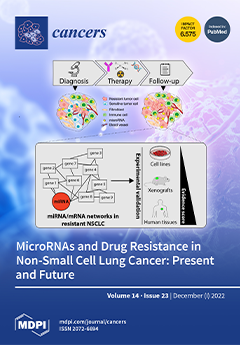The incidence of postoperative pneumonia (POP) in patients with cancer is high, but its incidence following major cancer surgeries is unclear. Therefore, we investigated the incidence and risk factors of POP after surgery in patients with the five most common cancers in Korea
[...] Read more.
The incidence of postoperative pneumonia (POP) in patients with cancer is high, but its incidence following major cancer surgeries is unclear. Therefore, we investigated the incidence and risk factors of POP after surgery in patients with the five most common cancers in Korea using a common data model (CDM). Patients aged >19 years who underwent gastric, colon, liver, lung, or breast cancer surgery between January 2011 and December 2020 were included, excluding patients who underwent chemotherapy or radiotherapy. Pneumonia was defined as a pneumonia diagnosis code in patients hospitalized postoperatively. Gastric, colon, lung, breast, and liver cancers were noted in 4004 (47.4%), 622 (7.4%), 2022 (24%), 958 (11.3%), and 839 (9.9%) of 8445 patients, respectively. The cumulative POP incidence was 3.1% (
n = 262), with the highest incidence in lung cancer (
n = 91, 4.5%), followed by gastric (
n = 133, 3.3%), colon (
n = 19, 3.1%), liver (
n = 14, 1.7%), and breast (
n = 5, 0.5%) cancers. In multivariable analysis, older age, male sex, history of chronic pulmonary disease, mood disorder, and cerebrovascular disease were POP predictors. The cumulative POP incidence in the five cancers using the CDM was approximately 3%. Older age, male sex, chronic pulmonary disease, mood disorder, and cerebrovascular disease were POP risk factors in patients with cancer.
Full article






